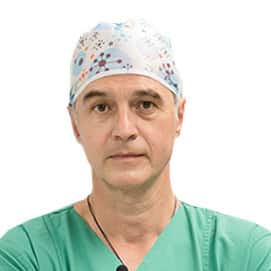If you suspect thyroid cancer, the doctor prescribes the necessary examinations. With their help, he can find out whether it is really a tumor and if so, what type of tumor it is, and how far the disease has gone.
Important research steps for detecting thyroid carcinoma:
History and clinical examination
First, the doctor finds out the patient's current complaints, background and possible risk factors (anamnesis). Then he conducts a thorough clinical examination of the patient. It includes probing the neck and thyroid gland, as well as lymph nodes. Thus, the doctor can already receive important indications about the type of disease.
Laboratory research
A blood test provides information about thyroid function by measuring thyroid hormones (triiodothyronine = T3 / thyroxine = T4) and TSH (thyroid stimulating hormone) produced by the pituitary gland. Medullary carcinoma (C-cell carcinoma) can be detected by measuring the hormone calcitonin. The next marker of this form of thyroid carcinoma is CEA (carcinoembryonic antigen).
Ultrasound examination (sonography)
Since the thyroid gland is located superficially, it is well accessible for ultrasound examination. Sonography provides information about the location and size of the thyroid gland, as well as the structure of changes in the thyroid gland and in the cervical lymph nodes. If a tumor is suspected, an additional ultrasound examination of the liver is done, in which a special search is made for daughter tumors (metastases).
Scintigraphy
Scintigraphy is a study that gives an image of organs using radioactively labeled substances. Thyroid tissue is distinguished by its ability to accumulate iodine. This is used in radioiodine scintigraphy: weakly radioactively labeled iodine is injected into the blood, it accumulates almost exclusively in active thyroid tissue and can be made visible with X-ray film. Since iodine remains in the body longer than technetium, as a rule, technetium is used for diagnosis, which enters the thyroid gland in the same way, but is excreted from the body much faster. Areas in which radioactive iodine/technetium accumulates especially a lot appear on the x-ray as so-called "hot nodes". Thyroid cancer can be hidden behind a "cold node", an area where little or no hormone is produced.
Since iodine can also accumulate in daughter tumors, this study is also suitable for searching for metastases, but only after complete surgical removal of the thyroid gland.
Biopsy with a thin hollow needle
To find out if the existing tumor is benign or malignant, the doctor may perform a biopsy with a thin hollow needle. In this ultrasound-guided examination, cells are taken from a suspicious area (such as the thyroid gland or lymph nodes) with a fine needle and then examined under a microscope (cytology). Often, the doctor can, using the data obtained, even before the operation find out what type of tumor is involved and thus better plan the operation. If only "normal" tissue is found on microscopic examination, carcinoma cannot be reliably excluded, as mature (highly differentiated) tumor cells may look like normal thyroid cells. The fears that are sometimes expressed that during the sampling of tumor cells they can be “washed out” are unfounded.
Computed tomography (CT), magnetic resonance imaging (MRI) and positron emission tomography (PET)
CT and MRI can make visible the spread of the tumor and its relationship to the border organs and tissue structures. The attending physician thus receives important information about how common the operation should be. Also, with the help of these studies, metastases and enlarged lymph nodes can be imaged and measured.
Recently, the so-called PET examination has been additionally carried out, which is performed in combination with CT (PET-CT). Tumors generally consume an increased amount of glucose compared to healthy tissue, so it is possible to make the tumor visible with the help of radioactively labeled glucose. But it must be taken into account that in a number of non-tumor diseases, this study can show a positive accumulation.
Laryngoscopy (examination of the larynx)
The purpose of laryngoscopy is to assess the condition of both vocal folds. The intact state of the vocal folds is indispensable for their normal functioning. Laryngoscopy is a study that is necessary for planning the operation and monitoring after it. Impaired function of the vocal folds may be a consequence of a previous operation on the thyroid gland. In the presence of a thyroid tumor, dysfunction of the vocal folds may be an indication of the spread of the tumor, since the nerves leading to the vocal cords pass before entering the larynx along the lower edge of both lobes of the thyroid gland.
Laryngoscopy can be direct or indirect. In indirect laryngoscopy, a small mirror is inserted into the mouth. Through a second mirror fixed on the doctor's forehead, the light is directed to the mirror in the mouth, so that the throat and larynx with vocal cords are clearly visible. The examination is simple and painless and can be performed without anesthesia. In addition to indirect laryngoscopy, direct laryngoscopy can be performed. In this examination, the doctor inserts an endoscope (in this case called a laryngoscope) through the patient's mouth and throat. A laryngoscope is a flexible tube equipped with a light source and a small camera. The doctor can thus directly examine and evaluate the condition of the vocal cords.
Endoscopic examination of the trachea and esophagus
Endoscopic examination of the trachea and esophagus is carried out in case of suspicion that the tumor also affected these two organs. In this study, the endoscope is inserted through the nose into the trachea or through the mouth and throat into the esophagus. An endoscope is a highly flexible, finger-thin fiberglass instrument equipped with a light source and a small camera. The doctor can view the inner walls of these two organs on the monitor in this way. If at the same time the doctor detects suspicious changes, then he can take tissue samples (biopsy) with the help of small tweezers located in the endoscope. The samples are then examined under a microscope histologically for cancer cells. As a rule, before the examination, the patient receives a mild sedative medication to anesthetize the mucous membranes, so that he does not feel any pain. The examination does not last long and can usually be done on an outpatient basis.
Head of the Clinic for General, Visceral, Thoracic and Endocrine Surgery
Head of the Clinic for General, Visceral and Minimally Invasive Surgery
Video
Request appointment
Useful links
Photo gallery












